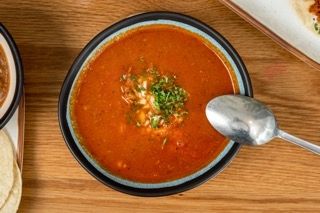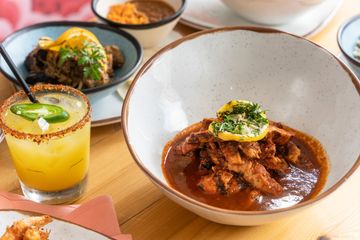Enjoy perfectly balanced hand crafted margarita blends that enhance your dining experience
Wiki Article
Why Mexican Food Is Famous: Discovering the Cultural Significance Behind the Dishes
Mexican cuisine stands out for its vivid flavors and deep social origins. The combination of spanish and aboriginal impacts creates a distinct cooking identification. Each recipe informs a tale of event, community, and tradition. Active ingredients like corn and chili peppers play crucial duties fit these narratives. To recognize the complete value of these cooking methods, one have to discover the layers of background and definition that enhance every bite. What lies below the surface area of this beloved cuisine?The Historic Origins of Mexican Food
Although Mexican cuisine is commonly celebrated for its varied ingredients and lively tastes, its historic roots run deep, reflecting a rich tapestry of social influences. Originating from old Mesoamerican human beings, such as the Aztecs and Mayans, Mexican food developed with centuries of farming techniques that integrated neighborhood crops like maize, beans, and chili peppers. The arrival of Spanish colonizers in the 16th century presented new active ingredients, including dairy products, rice, and pork, which melded with native traditions to develop unique culinary fusions. This mix of influences not just formed the dishes but additionally stood for the social and social characteristics of the time. Throughout the years, local variants arised, affected by geography, climate, and regional custom-mades. Mexican food stands as a representation of its historic journey, personifying the strength and adaptability of its people while celebrating their heritage via food.Regional Variety and Its Effect On Flavors
Regional variety plays a vital function in shaping the tastes of Mexican cuisine, with each area contributing special components based on local agriculture and custom. Typical food preparation strategies better boost these tastes, reflecting the custom-mades and backgrounds of individuals. Furthermore, the varying climates across Mexico influence which active ingredients thrive, resulting in distinctive regional dishes that celebrate the nation's cooking richness.
Distinct Ingredients by Region
Mexican food showcases an impressive array of distinct components that differ substantially across its diverse areas, each contributing cooking strategies and distinctive tastes. In the seaside areas, seafood such as shrimp and fish are staples, typically combined with tropical fruits like mango and coconut. The central highlands are known for their rich variety of beans, corn, and squash, developing the basis of many traditional dishes. In the Yucatán Peninsula, achiote and sour oranges impart a distinct taste account, while the northern regions favor beef and wheat-based meals, mirroring the influence of bordering societies. Each area's environment and location shape the neighborhood ingredients, developing a vibrant tapestry of flavors that highlight Mexico's abundant cooking heritage.
Standard Cooking Strategies
The varied ingredients discovered throughout Mexico not just shape the dishes however likewise affect the conventional cooking methods utilized in each area. In Oaxaca, the use of a stone mortar and pestle, recognized as a "metate," is common for grinding corn and spices to create masa and mole. On the other hand, coastal regions often utilize grilling and steaming methods to prepare fish and shellfish, reflecting their access to fresh catch. The highlands may emphasize slow-cooking approaches, such as barbacoa, where meats are covered in maguey leaves and hidden in the ground. Each method is deeply rooted in the local society, showcasing the significance of custom while enhancing the distinctive flavors that characterize Mexican food across diverse landscapes.Climate's Taste Influence
Although environment differs substantially across Mexico, it plays a vital function in forming the tastes and components that define the country's cuisine. Different areas experience distinct climate patterns, affecting the farming output and cooking methods. The dry north is understood for its hearty meats, while the lush south offers a wealth of exotic fruits and vegetables. Coastal areas take advantage of fresh seafood, which becomes a staple in their dishes. In addition, the highlands produce distinct natural herbs and flavors that contribute to regional specialties. This weather diversity not just enhances the flavor accounts of Mexican cuisine but also mirrors the social identification of each area, showcasing the deep link between the environment and culinary heritage.The Function of Ingredients in Culinary Identification
Important to recognizing culinary identification, the components of a cuisine reveal deep historic narratives and cultural connections. In Mexican cuisine, staples such as corn, beans, and chili peppers offer not just as fundamental elements but also as signs of strength and adaptation. Corn, as an example, is sacred, reflecting its value to aboriginal societies and farming methods. The variety of beans showcases the nation's biodiversity, while chili peppers include depth and warm, representing local variants and cooking imagination.These components are intertwined with routines, practices, and regional customs, highlighting the relevance of area fit cooking identity. The combination of herbs like cilantro and spices such as cumin additional enriches the taste account, demonstrating the impact of both early american backgrounds and aboriginal practices. Jointly, these components develop a dynamic tapestry that mirrors the complexities of Mexican society, making its food a powerful expression of identity and heritage.
Traditional Food Preparation Strategies and Their Relevance
Typical cooking strategies in Mexican cuisine act as a crucial web link to the nation's heritage, maintaining ancient approaches gave via generations. These techniques not only show local variety but likewise enhance the unique flavors that specify the food. Recognizing their relevance reveals the social richness embedded in every dish.Ancient Techniques Protecting Heritage
While modern-day culinary techniques have actually transformed the landscape of Mexican cuisine, ancient techniques stay an important link to the country's abundant heritage. Strategies such as nixtamalization, the process of treating corn with lime to improve its nutritional worth, have been pivotal fit traditional meals. The use of clay pots and rock mortars, known as molcajetes, also mirrors the emphasis on authenticity and taste that has actually been passed down via generations. These approaches not just preserve the honesty of ingredients but also embody cultural practices and communal worths. By remaining to utilize these old techniques, contemporary Mexican chefs maintain a link to their forefathers, making sure that the cookeries remain dynamic and reflective of the nation's diverse history.Regional Techniques and Flavors
As varied as its landscapes, Mexican food is identified by a myriad of regional techniques and flavors that mirror the special cultural impacts and regional active ingredients of each location. In Oaxaca, using the comal for food preparation tortillas demonstrates a custom passed down via generations, while the Yucatán area showcases the slow-cooking approach called cochinita pibil, highlighting marinaded pork wrapped in banana leaves. Coastal locations highlight fish and shellfish preparations, with strategies like ceviche showing spanish and aboriginal influences. Each area's distinctive flavors, such as the great smoky chipotle from Veracruz or the vivid chilies from Puebla, add to an abundant tapestry of flavors - take out and delivery. These traditional techniques not just enhance cooking diversity yet additionally work as a reflection of the durability and imagination of Mexican societyFestivities and events: Food as a Social Expression
Events and celebrations in Mexico are often marked by a range of lively meals that show the nation's abundant cultural heritage. Typical meals, such as tamales during Día de los Muertos and pozole throughout Self-reliance Day, display cooking methods and local components, symbolizing community and domestic bonds. Food becomes a medium for narration, with each recipe lugging historical relevance and regional identities.Along with the recipes themselves, the routines bordering cooking and usage play a necessary duty in these parties. Families gather to develop elaborate meals, fostering connections and preserving customs gave through generations. The public nature of these cooking methods highlights the significance of sharing food as an expression of love and unity. With these festive celebrations, Mexican cuisine transcends simple nourishment, functioning as a social emblem that commemorates heritage, spirituality, and the delight of togetherness.
International Influence and Acknowledgment of Mexican Gastronomy
Just how has Mexican gastronomy obtained such extensive acclaim worldwide? The response lies in its vibrant tastes, diverse components, and rich cultural heritage that resonate internationally. Acknowledged by UNESCO as an Intangible Social Heritage of Mankind, Mexican food showcases a special mix of spanish and indigenous impacts, making it distinct and appealing.Restaurants specializing in Mexican dishes have proliferated internationally, introducing genuine flavors such as mole, tacos, and tamales to varied tastes buds. The popularity of Mexican food has actually additionally been boosted by celebrity chefs and food preparation programs, which highlight its culinary methods and practices.
Additionally, food events and cultural occasions commemorate Mexican gastronomy, further boosting its condition on the globe phase. Therefore, Mexican cuisine transcends boundaries, promoting appreciation for its historical relevance and cooking artistry, ensuring its long-lasting influence in the global culinary landscape.
Often Asked Inquiries
What Are the Health Advantages of Typical Mexican Recipes?
Standard Mexican recipes offer countless health advantages, including high fiber material from vegetables and legumes, healthy fats from avocados, and essential nutrients from seasonings. These active ingredients add to improved food digestion, heart wellness, and general wellness.
How Can I Recreate Authentic Mexican Dishes at Home?
To recreate authentic Mexican recipes in your home, one must resource fresh ingredients, make use of typical food preparation strategies, discover local variations, and adhere to dependable recipes while welcoming the social subtleties and lively tastes integral in Mexican cuisine. (New York Times rated)What Duty Do Spices Play in Mexican Cooking?
Flavors are vital in Mexican cooking, boosting fragrances and tastes. They provide deepness and complexity to dishes, mirroring regional variety. Common seasonings like oregano, cumin, and chili add to the dynamic, bold accounts characteristic of Mexican food.Are There Vegetarian or Vegan Options in Mexican Cuisine?
Yes, Mexican cuisine supplies various vegan and vegan options. Dishes such as chiles rellenos, nopales, and various bean preparations display the rich tastes and ingredients readily available, making it available for those adhering to plant-based diets.Exactly How Has Mexican Cuisine Influenced Other Worldwide Foods?
Mexican food has greatly influenced global foods with the intro of components like corn, beans, and chili peppers, inspiring combination meals and enhancing taste accounts in numerous culinary traditions, specifically in the USA and Latin America.Mexican cuisine stands out for its vivid flavors and deep social origins. Mexican food is usually celebrated for its varied active ingredients and lively tastes, its historic origins run deep, mirroring an abundant tapestry of cultural influences. Regional diversity plays an essential role in shaping the flavors of Mexican cuisine, with each area contributing special ingredients based on neighborhood farming and custom. Mexican cuisine showcases an exceptional array of one-of-a-kind ingredients that vary considerably throughout its varied regions, each contributing distinct flavors and cooking techniques. As hand crafted margarita diverse as its landscapes, Mexican food is characterized by a myriad of regional techniques and tastes that show the distinct cultural influences and regional active ingredients of each location.
Report this wiki page